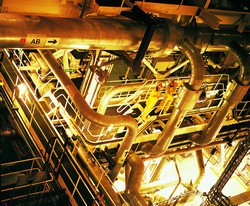Automated monitoring in superheated steam pipes
Most pipes transporting superheated steam in power plants are made of creep strength-enhanced ferritic steel. As is common with many materials, the heat-affected zone (HAZ) area next to the weld, which is not melted but experiences microstructural changes, is significantly weakened. HAZ failures are a major challenge and, although pipelines are periodically inspected for defects, errors in estimating the size of defects can have serious consequences. The EU funded the HOTPHASEDARRAY(opens in new window) (High temperature pipe structural health monitoring system utilising phased array probes on TOFD configuration) project to develop an ultrasonic SHM system to address this problem. The phased-array time-of-flight diffraction (PA-TOFD) ultrasound system will be deployable in the field and is capable of measuring the time evolution of defects in grade P91 stainless steel superheated pipes. Accurate measurement of size and changes over time will reduce uncertainty in service time predictions and scheduled pipe replacements. This in turn will minimise catastrophic failures and increase confidence in the operational safety of thermal power and nuclear energy plants. The consortium began by developing both the hardware and signal processing software needed to realise the PA-TOFD system. Scientists designed the instrumentation required and defined the essential input parameters, probe characteristics and inspection technique. Project partners also optimised the final piezoelectric probe design. On the signal processing side, researchers created the graphical user interface and evaluated filtering and averaging methods to increase the signal-to-noise ratio. The HOTPHASEDARRAY system is fully automated, remotely operated and permanently mounted on high-temperature pipes for SHM during operation. It is the first system to allow automated testing to be performed in service conditions to accurately and consistently measure crack development over time. Furthermore, the permanent installation of the system reduces human interference after installation and its high level of sensitivity enables the early stages of minor defects to be detected with 99.5 % accuracy. It will also benefit other industries that employ pipelines under high-temperature conditions, including chemical processing, refineries, and fossil fuel and solar power plants.



